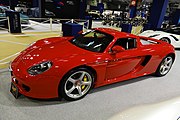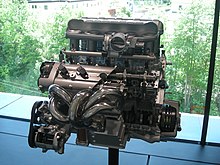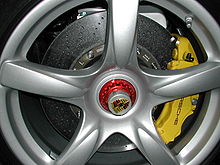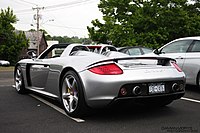| This article needs additional citations for verification. Please help improve this article by adding citations to reliable sources. Unsourced material may be challenged and removed. Find sources: "Porsche Carrera GT" – news · newspapers · books · scholar · JSTOR (August 2022) (Learn how and when to remove this message) |
Motor vehicle
| Porsche Carrera GT | |
|---|---|
 | |
| Overview | |
| Manufacturer | Porsche AG |
| Production | 2004–2006 (1,270 produced) |
| Assembly | Germany: Leipzig |
| Designer | Jason Hill (concept) Harm Lagaay (production) |
| Body and chassis | |
| Class | Sports car (S) |
| Body style | 2-door Targa roadster |
| Layout | Longitudinally mounted rear mid-engine, rear-wheel drive |
| Powertrain | |
| Engine | 5.7 L (5,733 cc) Porsche M80/01 DOHC V10 |
| Power output | 450 kW (612 PS; 603 hp) 590 N⋅m (435 lbf⋅ft) of torque |
| Transmission | 6-speed manual |
| Dimensions | |
| Wheelbase | 2,730 mm (107.5 in) |
| Length | 4,613 mm (181.6 in) |
| Width | 1,921 mm (75.6 in) |
| Height | 1,166 mm (45.9 in) |
| Curb weight | 1,380 kg (3,042 lb) |
| Chronology | |
| Predecessor | Porsche 911 GT1 Straßenversion |
| Successor | Porsche 918 Spyder |
The Porsche Carrera GT (Project Code 980) is a mid-engine sports car that was manufactured by German automobile manufacturer Porsche from 2004 to 2006. Sports Car International named the Carrera GT number one on its list of Top Sports Cars of the 2000s, and number eight on its Top Sports Cars of All Time list. For its advanced technology and development of its chassis, Popular Science magazine awarded it the "Best of What's New" award in 2003.
History
See also: Porsche LMP2000The development of the Carrera GT can be traced back to the 911 GT1 and LMP1-98 racing cars. In part due to the FIA and ACO rule changes in 1998, both designs had ended. Porsche at the time had planned a new Le Mans prototype for the 1999 season. The car was initially intended to use a turbocharged flat-six engine, but was later redesigned to use a new V10 engine – based on a unit secretly built by Porsche for the Footwork Formula One team in 1992 – pushing the project back to planned completion in 2000. The LMP 2000 was cancelled in November 1999, with rumours that the car had been cancelled as part of a deal with the Volkswagen Group to collaborate on the Porsche Cayenne, while also allowing Audi to compete at Le Mans without competition from Porsche.
-
 Porsche Carrera GT concept at Petersen Automotive Museum
Porsche Carrera GT concept at Petersen Automotive Museum
-
 Porsche Carrera GT concept at the 2000 Paris Motor Show
Porsche Carrera GT concept at the 2000 Paris Motor Show
Porsche did keep part of the project alive by using the 5.5 L V10 from the prototype in a concept car called the Carrera GT shown at the 2000 Paris Motor Show, mainly in an attempt to draw attention to their display. Surprising interest in the vehicle and an influx of revenue provided from the Cayenne helped Porsche decide to produce the car, and development started on a road-legal version that would be produced in small numbers at Porsche's new manufacturing facility in Leipzig. Porsche started a production run of the Carrera GT in 2004. The first Carrera GT went on sale in the United States on 31 January 2004.
Originally a production run of 1,500 cars was planned. However, Porsche announced in August 2005 that it would not continue production of the Carrera GT through to 2006, citing changing airbag regulations in the United States. By the end of production on 6 May 2006, more than 1,270 cars had been sold, with a total of 644 units sold in the United States and 31 units sold in Canada. In the United Kingdom, 49 units were sold.
Design
The Carrera GT is powered by a 5.7 L (5,733 cc) V10 engine rated at 450 kW (612 PS; 603 hp), whereas the original concept car featured a 5.5-litre version rated at 416 kW (566 PS; 558 hp). A road test in June 2004 by Car and Driver showed that the car can accelerate from 0–60 mph (97 km/h) in 3.5 seconds, 0–100 mph (161 km/h) in 6.8 seconds and 0–209 km/h (130 mph) in 10.8 seconds. The official top speed was 330 km/h (205 mph).
The Carrera GT was initially offered with five basic colours: Guards Red, Fayence Yellow, Basalt Black, GT Silver metallic and Seal Grey. Custom colours were later available from the factory. A traditional six-speed manual transmission is the only available transmission.
The Carrera GT has large side inlets and air dams that help cool the large V10 engine framed by the carbon fibre rear bonnet. Fitted with Porsche's latest Carbon fibre-reinforced Silicon Carbide (C/SiC) ceramic composite braking system, the 15-inch (380 mm) SGL Carbon disc brakes are fitted inside the 19 inch front and 20 inch rear 5-spoke alloy wheels. Similar to other Porsche models, such as the 911, the GT includes an electronically operated rear wing which deploys at speeds above 113 km/h (70 mph).
The interior is trimmed in soft leather. Bose audio system and a navigation system were standard. In typical Porsche fashion, the ignition is present to the left of the steering wheel. This placement dates back to the early days of Le Mans racing when drivers were required to make a running start, hop into their cars, start them and begin the race. The placement of the ignition enabled the driver to start the car with the left hand and put it in gear with the right.
- The basic colours available from the factory
-
 Fayence Yellow
Fayence Yellow
-
 Guards Red
Guards Red
-
 Basalt Black
Basalt Black
-
 Seal Grey
Seal Grey
-
 GT Silver
GT Silver
Technical specifications


- Engine
- Layout: Longitudinal, rear mid-engine, rear-wheel-drive layout
- Engine type: 68° V10, aluminium block and heads
- Code: 980/01
- Valvetrain: DOHC (chain-driven), 4 valves per cylinder (40 valves total), variable valve timing on intake camshafts, sodium-cooled exhaust valves
- Bore × stroke: 98 mm × 76 mm (3.86 in × 2.99 in), Nikasil coated bores, forged titanium connecting rods, forged pistons
- Displacement: 5,733 cc (5.7 L; 349.8 cu in)
- Compression ratio: 12.0:1
- Rated power: 450 kW (612 PS; 603 hp) @ 8,000 rpm
- Max. torque: 590 N⋅m (435 lb⋅ft) @ 5,750 rpm
- Specific output: 78.493 kW/L (105 hp/L)
- Weight to power ratio: 3.23 kg/kW (5.31 lb/hp)
- Redline: 8,400 rpm
- Transmission
- Clutch: Twin-plate ceramic dry-clutch (PCCC—Porsche Ceramic Composite Clutch)
- Gearbox type: 6-speed manual transmission
- Body
- Tank capacity: 92 litres
- Cargo volume: 76 L (2.7 cu ft)
- Max. payload: 180 kg (397 lb)
- Ground clearance: 3.4 in (86 mm)
- Dimensions:
- Length: 4,613 mm (182 in)
- Width: 1,921 mm (76 in)
- Height: 1,166 mm (46 in)
- Mass: 1,380 kg (3,042 lb)
- Track width: 1,612–1,587 mm (63–62 in)
- Wheelbase: 2,730 mm (107 in)
- Drag Coefficient: 0.39
- Fuel consumption for 2004 model
- EPA
- EPA Rated city, highway: 9 mpg‑US (26 L/100 km; 11 mpg‑imp)/15 mpg‑US (16 L/100 km; 18 mpg‑imp)
- Range: 241 miles (388 km)
- Tank in gal: 24.3 US gal (92 L; 20 imp gal)
- NEFZ:
- Consumption: 28.3 / 11.7 / 17.8 L/100 km
- CO2 emission: 429 g/km
- Emission level: EURO 4
- Estimated range: 516 km (321 mi)
- Auto Motor und Sport test:
- Max: 22.5 L/100 km
- Avg: 19.7 L/100 km
- EPA
Performance Test Results
- 0–60 km/h (0–37 mph) : 2.06 seconds
- 0–80 km/h (0–50 mph) : 2.61 seconds
- 0–100 km/h (0–62 mph) : 3.57 seconds
- 0–120 km/h (0–75 mph) : 4.33 seconds
- 0–140 km/h (0–87 mph) : 5.13 seconds
- 0–160 km/h (0–99 mph) : 6.46 seconds
- 0–180 km/h (0–112 mph) : 7.59 seconds
- 0‒400 m (1⁄4 mi): 10.97 seconds
- 0‒1,000 m (0.62 mi): 19.42 seconds at 284 km/h (176.5 mph)
- Top speed: 334 km/h (208 mph) (official: 330 km/h (205 mph))
- 80–120 km/h (50–75 mph): 6.35 seconds (in 6th gear)
- Braking 100 mph (161 km/h) to 0: 277 feet (84 m)
- Braking 60 mph (97 km/h) to 0: 101 feet (31 m)
- Braking 100 km/h to 0: 33.5 m
- Skid pad, 200 ft (61 m) ave g: 0.99
Sport Auto tested a maximal lateral acceleration of 1.35 g, even 1.4 g was reached at the Schwalbenschwanz section of the Nürburgring Nordschleife, Motor Trend tested 11.1s at 133.4 mph (215 km/h) for the 1⁄4 mile (402 m).
Track tests
- Nürburgring Nordschleife: 7:28
- Nürburgring Nordschleife (2024): 7:12
- Bedford Autodrome: 1:20.2
- Top Gear Test Track: 1:19.8
Technology

Notable technology includes a pure carbon fibre monocoque and subframe produced by ATR Composites Group of Italy, dry sump lubrication and inboard suspension. At speeds above 113 km/h (70 mph), the electronically operated rear wing raises into the airstream to reduce lift. The radiator of the Carrera GT is about five times the size of that of a 911 Turbo of its time. The car's front and rear suspension system consists of pushrod actuated shock absorbers and dampers with anti-roll bars.
Zagato

In 2013, Zagato introduced the Porsche Carrera GTZ based on the Porsche Carrera GT. Commissioned by a Swiss Porsche collector and former racing driver, it has a modified carbon fiber body which is more aerodynamic. The car has the same technical specification as the Porsche Carrera GT. Six Carrera GTZs were built.
References
Notes
- ^ "RSsportscars: Porsche Carrera GT". RSsportscars. Retrieved 17 February 2015.
- ^ "Serious Wheels: Porsche Carrera GT". Serious Wheels. Retrieved 4 May 2007.
- "Porsche Carrera GT Specifications" (PDF). Archived from the original (PDF) on 19 February 2018. Retrieved 11 December 2017.
- Larry Webster (June 2004). "Porsche Carrera GT - Road Test Page 2: Handling Precision". Photography by Markus Leser. Caranddriver.com. Retrieved 30 April 2017.
- ^ "Porsche Carrera GT - Auto Shows". Car and Driver. Archived from the original on 7 May 2008. Retrieved 22 March 2016.
- Mike Hanlon (11 May 2006). "Production ends on Porsche Carrera GT: the most successful supercar in history". Newatlas.com. Retrieved 30 April 2017.
- Fuller, Michael J. "Porsche 9R3 LMP1 1999–2000". Mulsanne's Corner. Retrieved 19 February 2014.
- Watkins, Gary (24 October 2024). "McNish returns to the cockpit of unraced Porsche LMP2000, 25 years after car's only test". Autosport. Retrieved 2 November 2024.
- Euwema, Davey (23 October 2024). "Insight: Bringing Porsche's Most Elusive Le Mans Project Back to Life". Sportscar365+. Retrieved 2 November 2024.
- Brownall, Bradley (7 January 2014). "Porsche's LMP 2000 Project". FlatSixes. Retrieved 19 February 2014.
- "Production Ends on Porsche Carrera GT: the Most Successful Supercar in History". Porsche Press Release. Porsche Cars North America Inc. 9 May 2006. Archived from the original on 1 September 2015. Retrieved 15 April 2015.
- "Porsche Club Great Britain: Carrera GT Registry". Retrieved 1 December 2016.
- ^ "Porsche Carrera GT - Road Test". Car and Driver. Retrieved 27 January 2016.
- ^ "A Twist of Le Mans: Ferrari Enzo, the Porsche Carrera GT, and the Ford GT". motortrend.com. Retrieved 3 October 2010.
- ^ auto motor und sport: Technische Daten Porsche Carrera GT 5.7 V10 . April 2011.
- "Celebrating 20 years of the Porsche Carrera GT". 11 November 2020.
- "Celebrating 20 years of the Porsche Carrera GT". 11 November 2020.
- "Porsche Carrera GT Specs". carsdirect.com. Retrieved 3 October 2010.
- ^ "2004 Porsche Carrera GT". fueleconomy.gov. Archived from the original on 14 June 2011. Retrieved 3 October 2010.
- ^ Auto Magazine 11/2008 Brief performance details Archived 18 November 2015 at the Wayback Machine (Retrieved 21 March 2016)
- ^ "Auto, Motor und Sport 2004 Die-300-km/h-Elite". www.auto-motor-und-sport.de. Archived from the original on 17 March 2016.
- Horst von Saurma (16 February 2011). "Porsche Carrera GT im Supertest". Retrieved 26 July 2016.
- "Duell auf der Nordschleife - autobild.de". autobild.de. 18 June 2004. Retrieved 1 June 2018.
- "20 years later, Porsche smashes the Carrera GT's Nürburgring record with a simple DIY modification - We Are Wearside". 15 December 2024. Retrieved 31 December 2024.
- Richard Meaden (10 January 2007). "Litchfield Type-25 v Caterham CSR 260 v Lotus Exige S v Radical SR3 1300 v Ariel Atom v Porsche Carrera GT v Ford GT v Ferrari Enzo v McLaren F1". Evo. Retrieved 30 April 2017.
- "Porsche Carrera GT Car Review - Top Gear - BBC". British Broadcasting Corporation, YouTube. 15 August 2008. Retrieved 30 April 2017.
- "Porsche Carrera GTZ". www.zagato.it. Retrieved 12 January 2021.
Bibliography
- Holmes, Mark (2007). Ultimate Convertibles: Roofless Beauty. London: Kandour. pp. 124–127. ISBN 978-1-905741-62-5.
External links
| Porsche | |||||||
|---|---|---|---|---|---|---|---|
| Volkswagen Group marques & companies | |||||||
| Cars |
| ||||||
| Tractors | |||||||
| Motorsport |
| ||||||
| Engines and technologies | |||||||
| People |
| ||||||
| See also |
| ||||||
| « previous — Porsche road car timeline, 2000–present | |||||||||||||||||||||||||||||||||||||||||||||||||||||||||||||||||||||||||||||||||||||||||||||||||||||||||||||||||||||||||||||||||||||||||||||||||||||||||||||||||||||||||||||||||||||||||||||||||||||||||||||||||||||||||||||||||||||||||||||||||||||||||||||||||||||||||||
|---|---|---|---|---|---|---|---|---|---|---|---|---|---|---|---|---|---|---|---|---|---|---|---|---|---|---|---|---|---|---|---|---|---|---|---|---|---|---|---|---|---|---|---|---|---|---|---|---|---|---|---|---|---|---|---|---|---|---|---|---|---|---|---|---|---|---|---|---|---|---|---|---|---|---|---|---|---|---|---|---|---|---|---|---|---|---|---|---|---|---|---|---|---|---|---|---|---|---|---|---|---|---|---|---|---|---|---|---|---|---|---|---|---|---|---|---|---|---|---|---|---|---|---|---|---|---|---|---|---|---|---|---|---|---|---|---|---|---|---|---|---|---|---|---|---|---|---|---|---|---|---|---|---|---|---|---|---|---|---|---|---|---|---|---|---|---|---|---|---|---|---|---|---|---|---|---|---|---|---|---|---|---|---|---|---|---|---|---|---|---|---|---|---|---|---|---|---|---|---|---|---|---|---|---|---|---|---|---|---|---|---|---|---|---|---|---|---|---|---|---|---|---|---|---|---|---|---|---|---|---|---|---|---|---|---|---|---|---|---|---|---|---|---|---|---|---|---|---|---|---|---|---|---|---|---|---|---|---|---|---|---|---|---|---|---|---|---|
| |||||||||||||||||||||||||||||||||||||||||||||||||||||||||||||||||||||||||||||||||||||||||||||||||||||||||||||||||||||||||||||||||||||||||||||||||||||||||||||||||||||||||||||||||||||||||||||||||||||||||||||||||||||||||||||||||||||||||||||||||||||||||||||||||||||||||||




